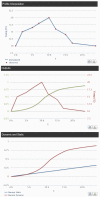Salmonella and Salmonellosis: An Update on Public Health Implications and Control Strategies
- PMID: 38067017
- PMCID: PMC10705591
- DOI: 10.3390/ani13233666
Salmonella and Salmonellosis: An Update on Public Health Implications and Control Strategies
Abstract
Salmonellosis is globally recognized as one of the leading causes of acute human bacterial gastroenteritis resulting from the consumption of animal-derived products, particularly those derived from the poultry and pig industry. Salmonella spp. is generally associated with self-limiting gastrointestinal symptoms, lasting between 2 and 7 days, which can vary from mild to severe. The bacteria can also spread in the bloodstream, causing sepsis and requiring effective antimicrobial therapy; however, sepsis rarely occurs. Salmonellosis control strategies are based on two fundamental aspects: (a) the reduction of prevalence levels in animals by means of health, biosecurity, or food strategies and (b) protection against infection in humans. At the food chain level, the prevention of salmonellosis requires a comprehensive approach at farm, manufacturing, distribution, and consumer levels. Proper handling of food, avoiding cross-contamination, and thorough cooking can reduce the risk and ensure the safety of food. Efforts to reduce transmission of Salmonella by food and other routes must be implemented using a One Health approach. Therefore, in this review we provide an update on Salmonella, one of the main zoonotic pathogens, emphasizing its relationship with animal and public health. We carry out a review on different topics about Salmonella and salmonellosis, with a special emphasis on epidemiology and public health, microbial behavior along the food chain, predictive microbiology principles, antimicrobial resistance, and control strategies.
Keywords: Salmonella; animal health; antimicrobial resistance; control strategies; food chain; one health; predictive microbiology; public health; salmonellosis.
Conflict of interest statement
The authors declare that they have no known competing financial interest or personal relationships that could have appeared to influence the work reported in this review.
Figures


Similar articles
-
Genome-Based Assessment of Antimicrobial Resistance and Virulence Potential of Isolates of Non-Pullorum/Gallinarum Salmonella Serovars Recovered from Dead Poultry in China.Microbiol Spectr. 2022 Aug 31;10(4):e0096522. doi: 10.1128/spectrum.00965-22. Epub 2022 Jun 21. Microbiol Spectr. 2022. PMID: 35727054 Free PMC article.
-
Salmonella Prevalence Alone Is Not a Good Indicator of Poultry Food Safety.Risk Anal. 2021 Jan;41(1):110-130. doi: 10.1111/risa.13563. Epub 2020 Jul 20. Risk Anal. 2021. PMID: 32691435
-
Salmonellosis: the role of poultry meat.Clin Microbiol Infect. 2016 Feb;22(2):110-121. doi: 10.1016/j.cmi.2015.12.004. Epub 2015 Dec 17. Clin Microbiol Infect. 2016. PMID: 26708671 Review.
-
Salmonellosis: An Overview of Epidemiology, Pathogenesis, and Innovative Approaches to Mitigate the Antimicrobial Resistant Infections.Antibiotics (Basel). 2024 Jan 13;13(1):76. doi: 10.3390/antibiotics13010076. Antibiotics (Basel). 2024. PMID: 38247636 Free PMC article. Review.
-
Practical Preventive Considerations for Reducing the Public Health Burden of Poultry-Related Salmonellosis.Int J Environ Res Public Health. 2023 Aug 25;20(17):6654. doi: 10.3390/ijerph20176654. Int J Environ Res Public Health. 2023. PMID: 37681794 Free PMC article. Review.
Cited by
-
Serovars, virulence factors, and antimicrobial resistance profile of non-typhoidal Salmonella in the human-dairy interface in Northwest Ethiopia: A one health approach.PLoS Negl Trop Dis. 2024 Nov 20;18(11):e0012646. doi: 10.1371/journal.pntd.0012646. eCollection 2024 Nov. PLoS Negl Trop Dis. 2024. PMID: 39565761 Free PMC article.
-
Potential Involvement of Reactive Oxygen Species in the Bactericidal Activity of Eugenol against Salmonella Typhimurium.Pathogens. 2024 Oct 14;13(10):899. doi: 10.3390/pathogens13100899. Pathogens. 2024. PMID: 39452770 Free PMC article.
-
Metal and metal oxide nanoparticle-assisted molecular assays for the detection of Salmonella.Discov Nano. 2025 Apr 2;20(1):65. doi: 10.1186/s11671-025-04237-3. Discov Nano. 2025. PMID: 40172753 Free PMC article. Review.
-
Phenotypic Characterization and Genome Analysis of New Broad-Spectrum Virulent Salmophage, Salmonella Phage KKP_3822, for Biocontrol of Multidrug-Resistant Salmonella enterica Strains.Int J Mol Sci. 2024 Dec 1;25(23):12930. doi: 10.3390/ijms252312930. Int J Mol Sci. 2024. PMID: 39684641 Free PMC article.
-
Prevalence, antimicrobial resistance pattern, and associated factors of Salmonella serovars among human-animal interfaces in the Amhara National Regional State, Ethiopia.BMC Infect Dis. 2025 May 29;25(1):771. doi: 10.1186/s12879-025-11170-4. BMC Infect Dis. 2025. PMID: 40442664 Free PMC article.
References
-
- World Health Organization (WHO) Critically Important Antimicrobials for Human Medicine, 6th Revision. World Health Organization; Geneva, Switzerland: 2018.
-
- Astorga R.J. Sanidad Animal y Salud Pública: El Paradigma de Salmonella. Editorial Amazing Books; Zaragoza, Spain: 2020. pp. 1–282.
-
- Gosling R.J., Mueller-Doblies D., Martelli F., Nunez-García J., Kell N., Rabie A., Wales A.D., Davies R.H. Observations on the distribution and persistence of monophasic Salmonella Typhimurium on infected pig and cattle farms. Vet. Microbiol. 2018;227:90–96. doi: 10.1016/j.vetmic.2018.10.032. - DOI - PubMed
Publication types
LinkOut - more resources
Full Text Sources
Miscellaneous

